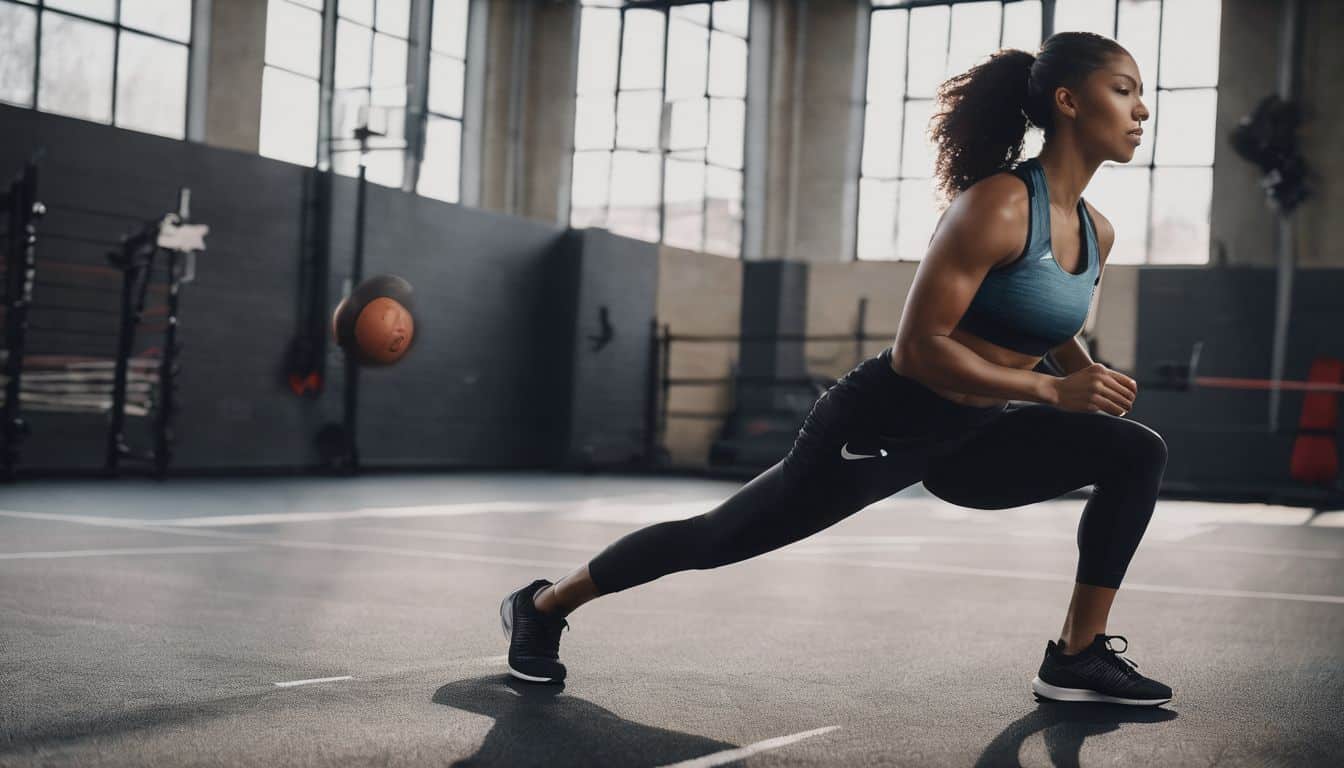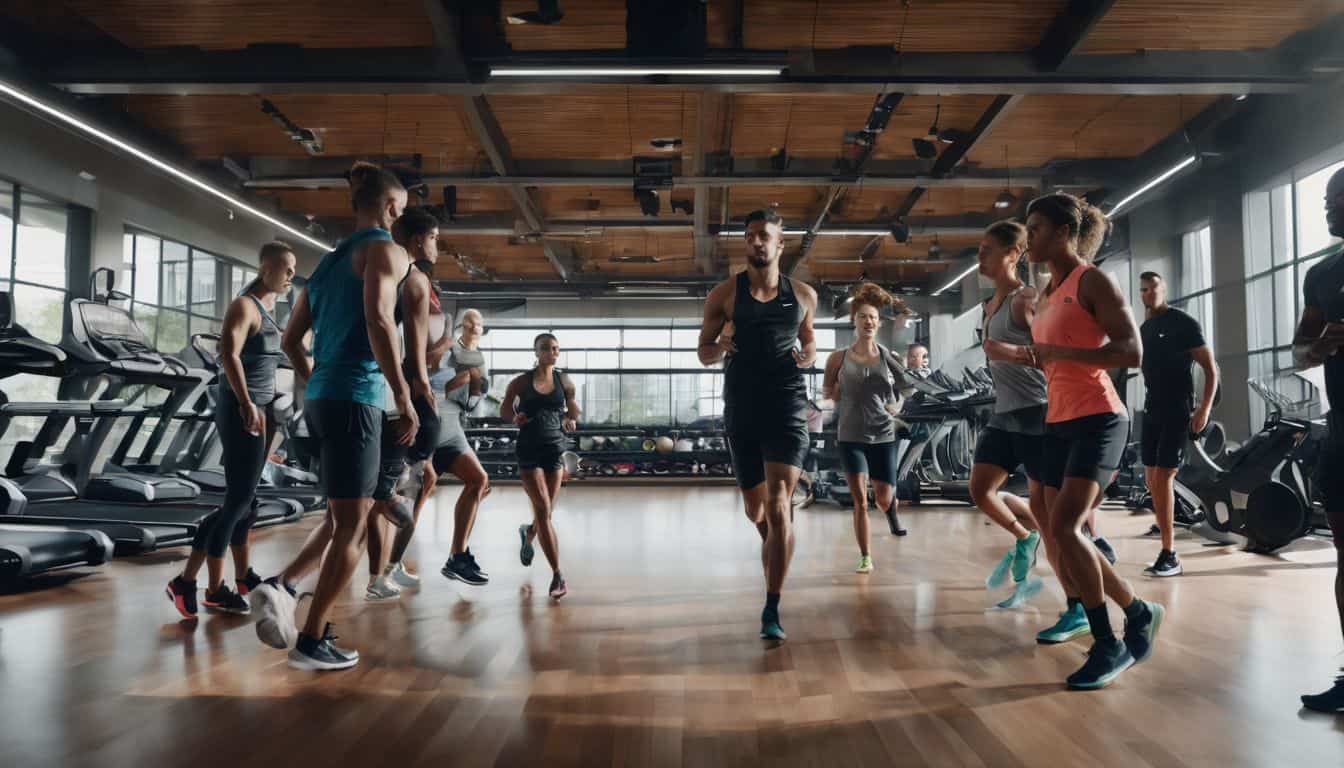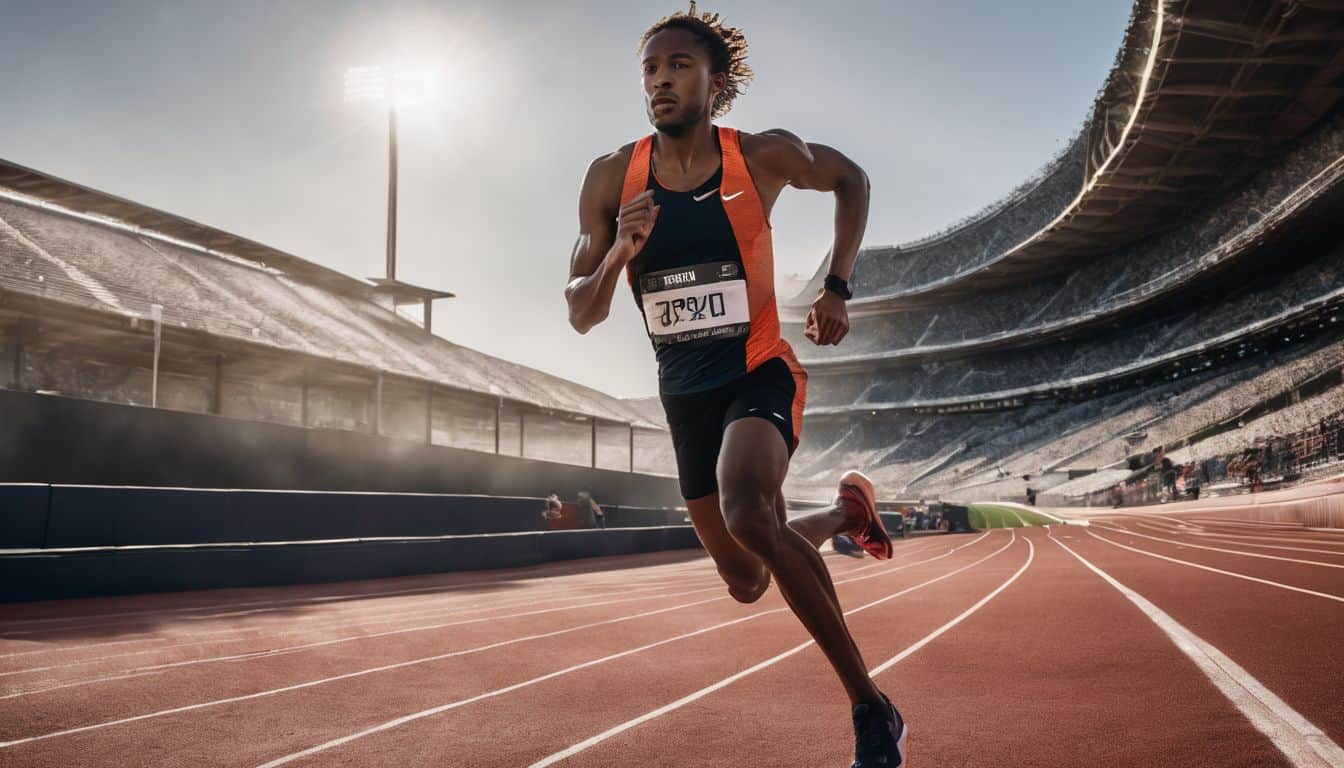Ever found yourself pondering over the difference between Nike Training shoes and Nike Running shoes? You’re in good company. This quandary has left many of us, yours truly included, a bit baffled until I decided to roll up my sleeves and really get into the nitty-gritty of their distinctive features and specific purposes.
What I discovered was that each pair is cleverly crafted with particular activities in mind, outfitted with cutting-edge technologies to elevate performance. Now let’s get you kitted out in the right gear!
Key Takeaways
- Nike Training shoes are designed for a wide range of activities, including strength training, HIIT, and yoga, while Nike Running shoes are specifically made for running.
- Nike Training shoes have a flat sole for balance during weightlifting and tough soles to handle various surfaces. Nike Running shoes are lightweight with cushioning that provides a comfortable running experience.
- Nike Training shoes provide more arch support and stability for lateral movements, while Nike Running shoes prioritize forward motion and shock absorption.
- Choosing the right shoe depends on your fitness goals and activities. If you do a variety of workouts or focus on strength training, go for Nike Training shoes. If you’re primarily into outdoor running or races, opt for Nike Running shoes.
Nike Training vs Nike Running: Key Differences
Nike Training and Nike Running have key differences in their purposes, activities, design, features, cushioning, support, flexibility, and stability.
Different purposes and activities
Nike Training and Nike Running serve different needs. Nike Training supports many fitness goals. It gives you workouts for strength training, High-Intensity Interval Training (HIIT), yoga, and more.
On the other hand, Nike Running is for runners only. It comes with features like route tracking, distance counting, and calorie burn info. Different shoes are made for these different plans and goals.
We choose them based on our own needs in training or running.
Design and features
Nike Training shoes are made for many sports. They have a flat sole that gives you balance when you lift weights or do squats. The soles of these athletic footwear are tough to handle all types of ground.
These workout shoes also hold your feet tight for quick moves and jumps.
Nike Running shoes help you run fast and far. They are light on your feet and let them breathe with airy tops. The bottoms of these sports shoes act like soft pads. When your foot hits the ground, they spring back up.
This makes each step feel good as if running on clouds!
Cushioning and support
Nike Training shoes show up with more padding in the midsole. They give a lot of support for your arch. These shoes keep you steady and help when you move from side to side. On the other hand, Nike Running shoes are made to help you go forward fast and easy.
They take in shock as you run. Shoes like these form a solid base for your whole body and can stop you from getting hurt. Also, some kinds like Winflo 10 let you do many types of workouts because they’re so comfy! Others such as Pegasus 40 are great for daily runs on roads because they’ve been improved for this year.
Flexibility and stability
Flexibility and stability are important considerations when comparing Nike Training shoes and Nike Running shoes. Training shoes are designed to offer greater flexibility, allowing for a wide range of movements during various workouts and strength training exercises.
In contrast, running shoes prioritize stability, providing support and preventing excessive sideways movement while running. This difference in design ensures that each type of shoe is optimized for its specific purpose, with training shoes accommodating dynamic movements and running shoes providing a stable platform for efficient forward motion.
In-depth Analysis: What Is The Difference Between Nike Training And Nike Running

In my in-depth analysis, I discovered some key differences between Nike Training shoes and Nike Running shoes. Firstly, the purposes and activities for which they are designed differ.
Nike Training shoes are created for a wide range of sports movements and exercises, not just running. On the other hand, Nike Running shoes are specifically built for outdoor running and jogging.
Secondly, the design and features of these two types of shoes also vary. Nike Training shoes prioritize flexibility and stability to support various movements during workouts. They may have less midsole cushioning and arch support compared to Nike Running shoes, which focus more on providing cushioning and support for long-distance running.
Lastly, when it comes to choosing between these two shoe types, it is essential to consider your fitness goals and activities. If you primarily engage in strength training or cross-training at the gym, Nike Training shoes would be suitable.
However, if you enjoy outdoor running or participate in races regularly , investing in a good pair of Nike Running shoes would be beneficial for your performance.
Remember that selecting the right shoe involves considering factors such as fit, comfort,and seeking expert advice if needed. It’s essential to understand specific features and technologies offered by each shoe type while keeping your foot type and biomechanics in mind.
So whether you’re hitting the gym or going out for a run,you can make an informed decision based on your needs with this knowledge about the difference between Nike Training and Nike Running Shoes
When to Wear Nike Training Shoes
Nike Training shoes are perfect for strength training and cross-training activities, gym workouts and classes, as well as functional movements and agility exercises.
Strength training and cross-training
When it comes to strength training and cross-training, it’s important to wear the right shoes. Nike training shoes are designed to provide stability and support for lateral movements and weightlifting.
These shoes are great for activities like HIIT, lifting, CrossFit, and other training exercises. They offer a balance of cushioning, support, and flexibility to help you move comfortably during your workouts.
Whether you’re jumping, lifting weights, dancing or stretching, Nike training shoes can keep up with your movements and provide the necessary support for optimal performance.
Gym workouts and classes
I find that wearing the right shoes for gym workouts and classes is crucial for my performance and comfort. When it comes to Nike training shoes, they are perfect for these activities.
They provide the necessary support and stability for exercises like weightlifting, HIIT workouts, and plyometrics. Specifically, the Nike Metcon 7 Flyease is highly recommended for lifting and high-intensity training.
These shoes are versatile enough to handle a variety of movements involved in gym workouts and classes, such as aerobics, plyometrics, and treadmill runs. So whenever I’m heading to the gym or attending fitness classes, I always make sure to wear my Nike training shoes to protect myself from potential injuries and optimize my workout experience.
Functional movements and agility exercises
Functional movements and agility exercises are an important part of any training routine. These exercises help improve strength, coordination, speed, and overall athletic performance.
Some examples of functional movements include squats, lunges, kettlebell swings, and core stability exercises. Agility exercises focus on quickness, speed, and coordination through drills like speed ladder exercises or cone drills.
When it comes to these types of exercises, it’s important to choose the right shoes that provide stability, support, traction, and flexibility. Nike training shoes are designed specifically for these activities to help minimize the risk of injury and enhance your performance during functional movements and agility workouts.
When to Wear Nike Running Shoes
Nike running shoes are designed for outdoor running, jogging, long-distance running, races, and performance and speed workouts.
Outdoor running and jogging
When I go for outdoor runs or jogs, I make sure to wear the right shoes. Nike running shoes are designed specifically for activities like these. They provide cushioning in the midsole and support your arches, which can help prevent injuries caused by overuse.
If you’re someone who tends to supinate (roll your feet outward), Nike running shoes with more cushioning and flexibility might be a good choice for you. Remember, there are also Nike training shoes that can be used for short-distance outdoor running and jogging, like the Nike Free Metcon 4 and Nike SuperRep Go.
So when it comes to outdoor running and jogging, having the proper footwear is really important!
Long-distance running and races
Long-distance running and races are all about endurance and pushing your limits. When it comes to these activities, it’s crucial to have the right pair of shoes that can provide the necessary cushioning for those long miles.
That’s where Nike Running shoes come in. With their cushioned design and advanced racing shoe technology, Nike Running shoes can give you a performance advantage during marathon races or when tackling those grueling distance runs.
They’re specifically engineered to help improve your speed and overall performance, allowing you to go the extra mile with optimal comfort and support. So if you’re into long-distance running or have a race coming up, make sure to consider Nike Running shoes for that extra edge on the road or trail.
Performance and speed workouts
When it comes to performance and speed workouts, it’s important to wear the right shoes for optimal results and injury prevention. Nike running shoes are designed specifically for activities like outdoor running, long-distance running, and races.
They incorporate technologies like cushioning and support to enhance your running efficiency and athletic performance. Some popular options include the Zoom Vaporfly 4% and ZoomX Vaporfly Next%.
These shoes may provide an advantage by potentially helping you achieve faster times. If you’re looking to improve your speed and overall performance during workouts, Nike running shoes are a great choice.
Choosing the Right Shoe for Your Needs
Consider your fitness goals and activities, find a shoe that fits well and feels comfortable, seek expert advice if needed, understand the specific features of each shoe type, take your foot type into account—make sure you choose the perfect Nike training or running shoes for your needs.
Learn more about finding the right fit here!
Consider your fitness goals and activities
When choosing between Nike training shoes and Nike running shoes, it’s important to consider your fitness goals and activities. Are you focused on improving your running performance or are you participating in a variety of workouts like weightlifting, HIIT, and cross-training? Your choice should align with the specific needs of your fitness routine.
For example, if you’re primarily engaged in outdoor running or long-distance races, Nike running shoes would be most suitable as they provide features like cushioning and support for enhanced performance.
On the other hand, if you’re more into strength training or agility exercises at the gym, then Nike training shoes would be a better fit due to their versatility and ability to cater to different workout types.
Fit and comfort
Choosing the right shoe for your needs is all about finding a comfortable fit. It’s important to have shoes that feel good on your feet while providing the support and cushioning you need.
Cushioning helps absorb impact during running, while a breathable design keeps your feet cool and dry. Take into account factors like arch support, toe box width, and heel cup depth to ensure the best fit.
Remember, finding a comfortable fit is key to enjoying your runs or training sessions without discomfort or pain.
Seek expert advice and try on different models
Finding the right shoe for your needs is important. Seek expert advice and try on different models to ensure you make the best choice. Experts can give you customized recommendations and offer injury prevention tips. By trying on different shoes, you can find the perfect fit and comfort. This process helps you understand which shoes suit your specific requirements. Remember, seeking expert advice and trying on different models is essential for finding the right shoe for your needs.
Understand the specific features and technologies of each shoe type
When choosing the right shoe for your needs, it’s important to understand the specific features and technologies of each shoe type. Here are some key factors to consider:
- Cushioning: Running shoes provide the appropriate cushioning needed for long distances, while training shoes may have different levels of cushioning depending on their intended use.
- Support: Different shoe types offer various levels of support based on your gait and foot type. Understanding whether you need stability or motion control can help you find the right fit.
- Flexibility: While both training and running shoes offer flexibility, they may differ in terms of how much movement they allow. Consider your activities and preferences when choosing a shoe with the right amount of flexibility.
- Footwear technologies: Various brands incorporate different technologies into their shoes to enhance performance and reduce excess movement. Look for features like midsole foam, lightweight materials, and responsive cushioning.
- Design features: Training shoes often have more supportive features like straps or overlays for lateral movements during workouts. Running shoes may prioritize breathability and lightweight construction for long-distance running.
Take into account your foot type and biomechanics
When choosing the right shoe for your needs, it’s important to consider your foot type and biomechanics. Everyone’s feet are different, so what works for someone else may not work for you.
Understanding your foot type can help you find a shoe that provides the right support and stability. Do you have high arches or flat feet? Knowing this information can guide you towards shoes with appropriate cushioning or arch support.
Additionally, considering your biomechanics, such as how your foot moves when you walk or run, will help determine if you need a shoe that controls pronation or offers extra stability features.
Conclusion on What Is The Difference Between Nike Training And Nike Running?
In conclusion, Nike Training and Nike Running shoes are designed for different purposes and activities. Training shoes provide cushioning and support for various gym workouts, while running shoes are specifically made for running and offer features to enhance performance.
It’s important to choose the right shoe based on your fitness goals and activities to ensure optimal comfort and support during exercise.
FAQs on What Is The Difference Between Nike Training And Nike Running?
1. What is Nike Training?
Nike Training refers to a range of athletic activities and workouts designed to improve overall fitness, strength, and endurance.
Answer: Nike Training includes various exercises and workouts aimed at improving overall fitness, strength, and endurance.
2. What is Nike Running?
Nike Running focuses specifically on activities related to running, such as training for races or improving running performance.
Answer: Nike Running focuses on activities related to running, like race training or improving running performance.
3. Can I use Nike Training shoes for running?
While some Nike Training shoes may be suitable for short-distance running or casual jogging, it’s recommended to choose specialized running shoes for longer runs or intense training due to their specific features designed for better support and cushioning during the activity.
Answer: While some Nike Training shoes can be used for short-distance or casual jogging, specialized running shoes are recommended for longer runs or intense training due to their specific features that provide better support and cushioning.
4. Are there any differences in the design of Nike Training and Nike Running shoes?
Yes, there are differences in the design of Nike Training and Nike Running shoes. In general, Nike Training shoes tend to offer more versatility with multi-directional traction patterns and support for lateral movements. On the other hand, Nike Running shoes emphasize cushioning, stability, and energy return during forward motion.
Answer: Yes, there are differences between the designs of both shoe types. Typically speaking:
– For multi-directional movements needed in various exercises – get a pair from ‘Nike’ made especially for cross-training.
– For forward motion while doing intensive walking/running/jogging – pick up one designed by ‘Nike’ specifically intended for this purpose.






Leave a Reply